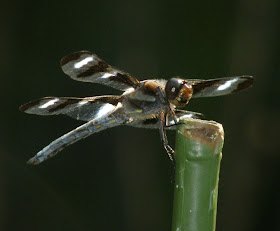I wandered into the blueberry patch, a sunny area protected from the wind, to photograph a flower of a tall Goldenrod. Then, quite to my surprise - one of those 'I don't know what made me look' moments - I spotted this female Common Green Darner hanging onto a branch of one of the blueberry bushes and basking in the warm sun.
Murphy’s Law prevailed. My camera batteries chose to go completely flat at that very instant. I’ve learned to carry spare batteries so that wasn’t a problem but I was afraid that she would leave while I was loading new batteries. Fortune smiled. She didn’t leave and she posed quite prettily while I took these photos.
 My first sighting…
My first sighting… A zoom photo…
A zoom photo… A macro photo…
A macro photo…Identification resources:
- Dragonflies of Georgia: Common Green Darner (Anax junius)
- BugGuide: Common Green Darner (Anax junius) [Male] [Female]
Click the image to view a larger image









.jpg)
.jpg)



































